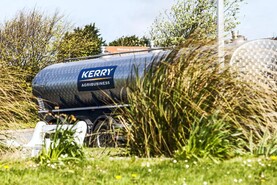James Taylor started milking during the spring of 2020. Having converted from suckling, James currently milks 255 spring-calving cows near Portrush, Co Derry.
Existing cattle housing was converted to suit dairy cows with little difficulty. However, a new building (80ft x 60ft) was constructed to accommodate the largest investment during the conversion – the parlour. With labour efficiency and a one-person operation in mind, James opted for a Gea rotary parlour supplied by McKnight Dairy Services. Some of the parlour’s key features are outlined in the pictures.
1 50-point parlour
The 50-point parlour measures 50ft in diameter and cost £200,000 (€222,222) to install. Rotation speed can be altered to suit cow numbers and stage of lactation yield. At peak yield in May, rotation time was around 12 minutes. This has been reduced to nine minutes at present. From start to finish, it currently takes just shy of 75 minutes to milk all 255 cows, including wash down, for a one-person operation.
2 Automated clusters

Picture 2 - Clusters are fully automated.
Once the parlour starts, clusters are automatically detached from retention cups, as each cow space rotates past the operator control position. Clusters are automatically removed once the cow is milked out.
3 Retention bar

Picture 3 - Anit-backing bars hold cows in the correct position as the parlour rotates.
As cows enter milking points, a retention bar is lowered to keep animals correctly positioned while the parlour rotates. The bar is automatically lifted when the cow approaches the exit point if milking is completed. If a cow kicks the clusters off mid-milking, the retention bar remains down, preventing the cow from exiting the parlour until she is fully milked out.
4 Teat spray

Picture 4 - Teat spray
On the floor of the parlour is an automatic teat spray, which is triggered as clusters are removed from each cow.
5-6 Washing points

Picture 5 - Parlour wash
Pictures five and six show two washing points. One point cleans the floor, while the second washes clusters after cows exit the parlour and again before they are re-attached to cows entering milking points. 
Picture 6 - Parlour wash
7 Heat detection
Picture 7 - Heat detection and auto drafting gates.
As cows exit the parlour, they pass through a handling race that includes heat detection technology and auto-drafting gates (Saber, LIC), to separate out animals for AI.
Read more
Cattle and sheep kills to remain suspended at Kildare Chilling
WATCH: Farm Tech Talk - the Livestock Show
James Taylor started milking during the spring of 2020. Having converted from suckling, James currently milks 255 spring-calving cows near Portrush, Co Derry.
Existing cattle housing was converted to suit dairy cows with little difficulty. However, a new building (80ft x 60ft) was constructed to accommodate the largest investment during the conversion – the parlour. With labour efficiency and a one-person operation in mind, James opted for a Gea rotary parlour supplied by McKnight Dairy Services. Some of the parlour’s key features are outlined in the pictures.
1 50-point parlour
The 50-point parlour measures 50ft in diameter and cost £200,000 (€222,222) to install. Rotation speed can be altered to suit cow numbers and stage of lactation yield. At peak yield in May, rotation time was around 12 minutes. This has been reduced to nine minutes at present. From start to finish, it currently takes just shy of 75 minutes to milk all 255 cows, including wash down, for a one-person operation.
2 Automated clusters

Picture 2 - Clusters are fully automated.
Once the parlour starts, clusters are automatically detached from retention cups, as each cow space rotates past the operator control position. Clusters are automatically removed once the cow is milked out.
3 Retention bar

Picture 3 - Anit-backing bars hold cows in the correct position as the parlour rotates.
As cows enter milking points, a retention bar is lowered to keep animals correctly positioned while the parlour rotates. The bar is automatically lifted when the cow approaches the exit point if milking is completed. If a cow kicks the clusters off mid-milking, the retention bar remains down, preventing the cow from exiting the parlour until she is fully milked out.
4 Teat spray

Picture 4 - Teat spray
On the floor of the parlour is an automatic teat spray, which is triggered as clusters are removed from each cow.
5-6 Washing points

Picture 5 - Parlour wash
Pictures five and six show two washing points. One point cleans the floor, while the second washes clusters after cows exit the parlour and again before they are re-attached to cows entering milking points. 
Picture 6 - Parlour wash
7 Heat detection
Picture 7 - Heat detection and auto drafting gates.
As cows exit the parlour, they pass through a handling race that includes heat detection technology and auto-drafting gates (Saber, LIC), to separate out animals for AI.
Read more
Cattle and sheep kills to remain suspended at Kildare Chilling
WATCH: Farm Tech Talk - the Livestock Show












 This is a subscriber-only article
This is a subscriber-only article










SHARING OPTIONS: